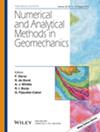Importance Sampling‐Enhanced Reliability Analysis of Double‐Row Piled Earth Slopes Accounting for Soil Spatial Variability
IF 3.4
2区 工程技术
Q2 ENGINEERING, GEOLOGICAL
International Journal for Numerical and Analytical Methods in Geomechanics
Pub Date : 2025-05-16
DOI:10.1002/nag.3998
引用次数: 0
Abstract
The application of stabilizing piles to increase slope stability is a common practice in slope engineering. Most related studies primarily focus on single‐row stabilizing piles; however, for large‐scale slopes, single‐row stabilizing piles may fail to meet the stability requirement, necessitating the use of double‐row or even multiple‐row stabilizing piles. Specifically, for large‐scale earth slopes where double‐row stabilizing piles are installed, the uncertainty and spatial variability of soil properties in the slope region may exert some probabilistic influence to the stabilizing efficiency. To address this probabilistic issue, this paper presents a reliability‐based analysis framework enhanced by importance sampling (IS) to quantify the stability of double‐row piled earth slopes, accounting for the soil spatial variability. The reliability analysis is efficiently realized by the first‐order reliability method (FORM) with考虑土壤空间变异性的双排桩土边坡重要性抽样增强可靠性分析
应用稳定桩提高边坡稳定性是边坡工程中常见的做法。大多数相关研究主要集中在单排稳定桩;然而,对于大型边坡,单排稳定桩可能无法满足稳定性要求,需要使用双排甚至多排稳定桩。具体而言,对于安装双排稳定桩的大型土质边坡,边坡区域土壤性质的不确定性和空间变异性可能对稳定效率产生一定的概率影响。为了解决这一概率问题,本文提出了一个基于可靠性的分析框架,通过重要性抽样(IS)来量化双排桩土边坡的稳定性,并考虑了土壤的空间变异性。采用一阶可靠性法(FORM)和iHLRFx迭代算法有效地实现了可靠性分析,采用is方法提高了可靠性分析的精度。此外,还采用karhunen - lo (KL)展开法进行了有效的随机场模拟。结合标准Optum G2边坡稳定性建模程序,采用KL‐iHLRFx‐IS可靠度集成方法,计算了不同桩设计方案组合下双排桩土边坡的可靠度指标,并对各种土壤不确定性和空间变异性参数进行了概率敏感性分析。
本文章由计算机程序翻译,如有差异,请以英文原文为准。
求助全文
约1分钟内获得全文
求助全文
来源期刊
CiteScore
6.40
自引率
12.50%
发文量
160
审稿时长
9 months
期刊介绍:
The journal welcomes manuscripts that substantially contribute to the understanding of the complex mechanical behaviour of geomaterials (soils, rocks, concrete, ice, snow, and powders), through innovative experimental techniques, and/or through the development of novel numerical or hybrid experimental/numerical modelling concepts in geomechanics. Topics of interest include instabilities and localization, interface and surface phenomena, fracture and failure, multi-physics and other time-dependent phenomena, micromechanics and multi-scale methods, and inverse analysis and stochastic methods. Papers related to energy and environmental issues are particularly welcome. The illustration of the proposed methods and techniques to engineering problems is encouraged. However, manuscripts dealing with applications of existing methods, or proposing incremental improvements to existing methods – in particular marginal extensions of existing analytical solutions or numerical methods – will not be considered for review.

 求助内容:
求助内容: 应助结果提醒方式:
应助结果提醒方式:


